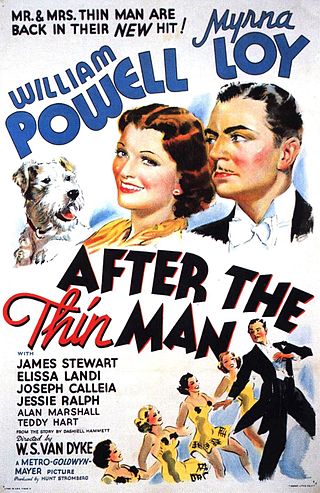
After the Thin Man is a 1936 American murder mystery comedy film directed by W. S. Van Dyke and starring William Powell, Myrna Loy and James Stewart. A sequel to the 1934 feature The Thin Man, the film presents Powell and Loy as Dashiell Hammett's characters Nick and Nora Charles. The film also features Elissa Landi, Joseph Calleia, Jessie Ralph, Alan Marshal and Penny Singleton.
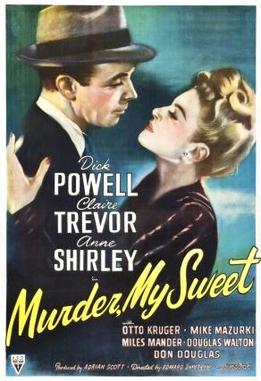
Murder, My Sweet is a 1944 American film noir, directed by Edward Dmytryk and starring Dick Powell, Claire Trevor and Anne Shirley. The film is based on Raymond Chandler's 1940 novel Farewell, My Lovely. It was the first film to feature Chandler's primary character, the hard-boiled private detective Philip Marlowe.

The Saint Strikes Back is a 1939 American crime film directed by John Farrow. It marks the second cinematic incarnation of the antihero crimefighting character Simon Templar, alias "The Saint". George Sanders replaced Louis Hayward, who had played the Saint in The Saint in New York. The movie was produced by RKO and also featured Wendy Barrie as female gang leader Val Travers. Barrie would appear in two more Saint films, playing different roles each time, though not in the next film in the series, The Saint in London. This was the second of eight films in RKO's film series about The Saint, and the first of five with Sanders in the title role.

Lionel Alfred William Atwill was an English and American stage and screen actor. He began his acting career at the Garrick Theatre. After coming to the United States, he appeared in Broadway plays and Hollywood films. Some of his more significant roles were in Captain Blood (1935), Son of Frankenstein (1939) and To Be or Not to Be (1942).

Barbary Coast is a 1935 American historical Western film directed by Howard Hawks. Shot in black-and-white and set in San Francisco's so-called Barbary Coast during the California Gold Rush, the film combines elements of the Western genre with those of crime, melodrama and adventure. It features a wide range of actors, from hero Joel McCrea to villain Edward G. Robinson, and stars Miriam Hopkins in the leading role as Mary 'Swan' Rutledge. In an early, uncredited appearance, David Niven plays a drunken sailor being thrown out of a bar.
Constantin Bakaleinikoff was a Russian-American composer.

Kenneth Macgowan was an American film producer. He won an Academy Award for Best Color Short Film for La Cucaracha (1934), the first live-action short film made in the three-color Technicolor process.
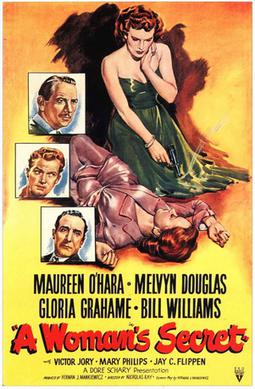
A Woman's Secret is a 1949 American film noir/mystery starring Maureen O'Hara, Gloria Grahame and Melvyn Douglas. Directed by Nicholas Ray, it was written and produced by Herman J. Mankiewicz based on the novel Mortgage on Life by Vicki Baum.

Brandon Hurst was an English stage and film actor.

The Ex-Mrs. Bradford is a 1936 American comedy mystery film. William Powell and Jean Arthur star as a divorced couple who investigate a murder at a racetrack. This was the last film directed by Stephen Roberts before his death from a heart attack.

The Canary Murder Case is a 1929 American pre-Code crime-mystery film based on the 1927 novel of the same name by S.S. Van Dine. The film was directed by Malcolm St. Clair, with a screenplay by Wright, Albert Shelby LeVino, and Florence Ryerson. William Powell starred in the role of detective Philo Vance, with Louise Brooks co-starred as "The Canary"; Jean Arthur, James Hall, and Charles Lane also co-starred in other principal roles.
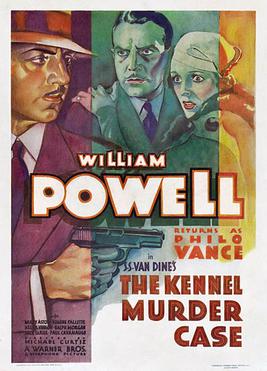
The Kennel Murder Case is a 1933 American pre-Code mystery film adapted from the 1933 novel of the same name by S. S. Van Dine. Directed by Michael Curtiz for Warner Bros., it stars William Powell and Mary Astor. Powell's role as Philo Vance is not the actor's first performance as the aristocratic sleuth; he also portrays the character in three films produced by Paramount in 1929 and 1930.

Etienne Girardot was a diminutive stage and film actor of Anglo-French parentage born in London, England.

The Plot Thickens is a 1936 American mystery film directed by Ben Holmes starring James Gleason, ZaSu Pitts and Louise Latimer. Pitts plays the schoolteacher and amateur sleuth Hildegarde Withers from Stuart Palmer's stories. Gleason reprised his role as Hildegarde's friendly nemesis, Inspector Oscar Piper, from RKO Radio Pictures' previous Hildegarde Withers films.
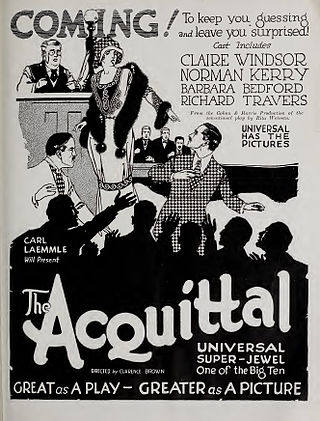
The Acquittal is a 1923 American silent mystery film based on the play of the same name by Rita Weiman. The film was directed by Clarence Brown, who would later start a long career at Metro-Goldwyn-Mayer. The film stars Norman Kerry, Claire Windsor, Richard Travers, and Barbara Bedford. The film was released by Universal Pictures.

Conspiracy is a 1930 American pre-Code mystery melodrama film produced and distributed by RKO Pictures and directed by Christy Cabanne. It is the second adaptation of the play The Conspiracy by Robert B. Baker and John Emerson and stars Bessie Love and Ned Sparks.
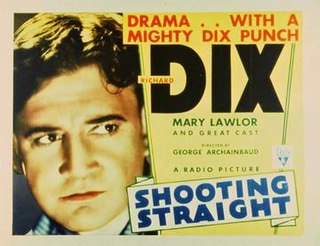
Shooting Straight is a 1930 American pre-Code crime drama film, directed by George Archainbaud and starring the early RKO staple Richard Dix and Mary Lawlor. The screenplay was written by J. Walter Ruben, from Wallace Smith's adaptation of a story by Barney A. Sarecky. It was one of the films that earned a positive return for RKO that year, turning a profit of $30,000.

The Casino Murder Case is a 1935 American mystery film starring Paul Lukas and Alison Skipworth. Rosalind Russell is in the supporting cast. It was directed by Edwin L. Marin from a screenplay by Florence Ryerson and Edgar Allan Woolf, based on the 1934 novel of the same name by S. S. Van Dine. It was the ninth film in the Philo Vance film series.
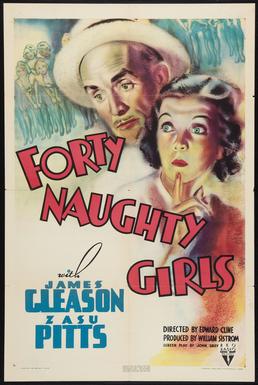
Forty Naughty Girls is a 1937 American comedy mystery film directed by Edward F. Cline and written by John Grey. The film stars James Gleason, ZaSu Pitts, Marjorie Lord, George Shelley and Joan Woodbury. It is the sixth and final entry in RKO Pictures' series of Hildegarde Withers films. This film was the sixth film in the Hildegarde Withers-Oscar Piper series, and the second film in which ZaSu Pitts appeared as Hildegarde. Before Pitts, Edna May Oliver and Helen Broderick had played the role.

The Firebird is a 1934 American murder mystery film starring Verree Teasdale, Ricardo Cortez, Lionel Atwill and Anita Louise, directed by William Dieterle and produced and released by Warner Bros. It is based on the 1932 play by Lajos Zelahy. The Firebird suite by Igor Stravinsky is heard occasionally during the film.



















